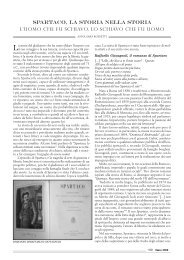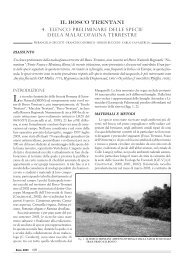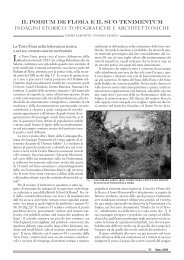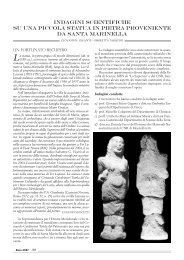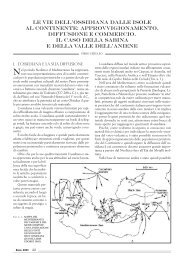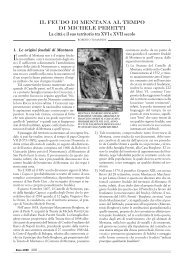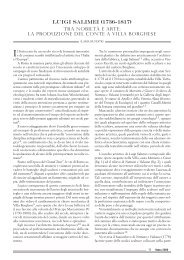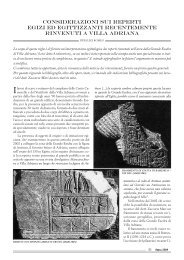Leggi - Associazione Nomentana di Storia e Archeologia Onlus
Leggi - Associazione Nomentana di Storia e Archeologia Onlus
Leggi - Associazione Nomentana di Storia e Archeologia Onlus
Create successful ePaper yourself
Turn your PDF publications into a flip-book with our unique Google optimized e-Paper software.
ely a spear, rather than a mace as later)... The god is also wearing the<br />
same garment wich is wear by the King, with the two hawks simbolizing<br />
Ra Horakhty and Ahura Mazda. Seth is clearly identified with<br />
Mithra and the King. Herodotus (III, 29) and Plutarch (De Iside 31,C)<br />
states that both Cambyses and Artaxerxes III sacrificed a bull (Surely<br />
not an Apis) after the fall of Egypt in 525 and 341 b.C. Accor<strong>di</strong>ng to<br />
Plutarch, Artaxerxes, after the sacrifice, dealed the bull’s meat to his retainers,<br />
identifing himself with Mithra, restoring the pact between Ahura<br />
Mazda and the mankind, <strong>di</strong>sturbed by the egyptian revolt. Significantly,<br />
when he accomplied this act, Artaxexes was identified with<br />
Typhon, i.e. Seth, as stated by Plutarch (loc. cit.). Seth was so strictly<br />
linked with the Persian King, that in a text from Edfu, dating to several<br />
century later, the god is called mdy, “the Mede”.<br />
In the sanctuary of the temple of Hibis is also showed several times<br />
Astarte; two times she is clearly identified with Anahita, thr grastest<br />
persian goddes: on the South Wall Astarte wears yhe tipical persian,<br />
headgear, well-known from a great number of representations. On the<br />
North Wall the goddess wears the red crown of the Lower Egypt – and<br />
is identified with Neith of Sais – and, in the right hand, carries the sa-<br />
1) In TRIGGER et Al., Ancient Egypt-A<br />
Social History, Cambridge 1983 (trad. it. Roma-Bari<br />
1989, p. 375).<br />
2) Ibid.<br />
3) E. BRESCIANI, “L’Egitto e l’impero persiano”,<br />
in H. BENGSTON (cur.), Greci e Persiani,<br />
Milano 1967, p. 291.<br />
4) His. III, 2.<br />
5) Ateneo XIII, 10; Ctesia, fragm. 13.<br />
6) LLOYD, p. 372. GRIMAL ipotizza<br />
che Cambise, nella sua spe<strong>di</strong>zione a Siwa,<br />
avesse per scopo la conferma della propria regalità<br />
per bocca dell’oracolo <strong>di</strong> Amon (Histoire<br />
de l’Egypte Ancienne, Paris 1988, trad. it. Roma-Bari<br />
1990, p. 471). Ciò non sembra probabile,<br />
data la <strong>di</strong>fferenza tra la posizione <strong>di</strong><br />
Cambise e quella <strong>di</strong> Alessandro Magno, non<br />
avendo il primo la necessità <strong>di</strong> rafforzare la<br />
propria posizione, a <strong>di</strong>fferenza del secondo.<br />
7) LANCZOWSKI, “Zur Entstehung de<br />
Antik Sinkratismus: Darius als Sohn der Neith<br />
von Sais”, Saeculum VI (1955), pp. 227-243.<br />
8) E. BRUNNER TRAUT, Ägyten, VI ed.<br />
(trad. it. Verona 1991, p. 802).<br />
9) J. LECLANT, “Astarte à cheval d’apres<br />
les raprésentations égyptiennes” Syria XXXVIII<br />
(1960), p. 51 n. 5.<br />
10) N. DE GARIES DAVIES, The Temple<br />
of Hibis in El Kharga Oasis, III The Decoration,<br />
New York 1953, pl. 23, 30-33; trad. fr. in. A.<br />
BARUCQ, F. DAUMAS, Hymes et prieres de<br />
l’Egypte Ancienne, Paris 1980, pp. 301 segg.<br />
11) Prob. Khepry, come nel pap. Berlin<br />
3055: BARUCQ, DAUMAS, p. 330.<br />
12) Ibid.<br />
13) Ibid., pag. 325 e n. AV: “gmhsu (WB<br />
V, 172) designe un oiseau de proie qui simbolise<br />
le <strong>di</strong>eu du ciel et du soleil” e traducono con épevier.<br />
14) Ibid. p. 328. Amon è qui chiamato<br />
“b3 (tradotto come “ariete”, ma può essere<br />
“anima”, ivi, n. bo) dalle 777 orecchie e dai mi-<br />
ANNALI2006 44<br />
lioni e milioni <strong>di</strong> occhi”: cfr. lo Yasht 10,7 dell’Avesta:<br />
“Mithra che ha mille orecchie ed è ben<br />
fatto, che ha mille occhi ed è grande”: G. GNO-<br />
LI, “Sol Persice-Mithra”, in U. BIANCHI<br />
(cur.) Mysteria Mithrae, Roma-Leiden 1979<br />
(EPRO LXXX) pp. 725 segg. e Id., “Politica<br />
religiosa e concezione della regalità sotto gli Achemeni<strong>di</strong>”,<br />
in Stu<strong>di</strong> in on. <strong>di</strong> G. Tucci, Napoli<br />
1974, pp. 24-88.<br />
15) N. SEKUNDA, The Persian Army<br />
560-330 bC, London 1992, p. 13, 45, 48, H.<br />
LUSCHEY, AMI, 5 (1972), pl. 69.<br />
16) Anab. I, 10-12.<br />
17) “Un’aquila d’oro con le ali spiegate, infissa<br />
sopra un’astra” Xen. loc. cit.<br />
18) PLUT. Art., 10.<br />
19) R.D. BARNETT, D.J. WISEMANN,<br />
Fifty Masterpieces of Ancient Near Eastern Art<br />
in the Departement of Western Asiatici Antiquities<br />
The British Museum, London 1969, p. 95;<br />
J. OATES, Babylon, p. 187, fig. 80.<br />
20) Sekunda, p. 45.<br />
21) A. SH. SHAHBAZI, in Zeitschrift fur<br />
Deutschen Morgenläneischer Gesellschäft 134<br />
(1984), pp. 314-317<br />
22) Nel prenome <strong>di</strong> Dario II amon Ra sostituisce<br />
Ra: Wsr hps˘ mry Imn R nb H. bt:<br />
BUDGE, Hier. Dic.,<br />
˘<br />
II, p. 941, 379.<br />
23) J. DUCHESNE-GUILLEMIN, “L’Iran<br />
Antico e Zoroastro”, in CH. H. PUECH<br />
(cur.) <strong>Storia</strong> delle Religioni, II (trad. it. Roma-<br />
Bari 1977, pp. 159-160).<br />
24) R. GHIRSHNAM, Iran from the Earliest<br />
time to Islamic Conquest, Harmondsworth,<br />
1954 (trad. it. Torino 1972, p. 120).<br />
25) E. BRESCIANI, op. cit., p. 294; W.<br />
Spiegelberg, “Drei demotischen Schreiben aus<br />
der Korrespondenz des Pherendates, des Satrapen<br />
Darius’ I mit den Chnum Priestern von<br />
Elephantine”, Sitzungsberiche d. Preuss. Ak.<br />
der Wissenschaften (1928), pp. 604 segg.<br />
26) Probabilmente templi analoghi doveva-<br />
cred barsom. Neith, as goddess of the primeval waters and patroness of<br />
the Saite Kings was identified from the times of Cambyses, with<br />
Anahita; was a hig priest of Neith, Hud jahorresnet, who linked egyptian<br />
and persian thoughts, maybe during his sojourn at Cambyses’court<br />
at Susa; on the autobiographical text on his statue, ha states to have act<br />
by King’s order. In the temple of Hibis, Darius II is shown suckled by<br />
Neith, in a scene that E. Brunner Traut descrived as “a shorted mammisi”.<br />
Astarte was identified with Anahita also in the Near East; in<br />
Egypt, she seems to be identified with the persian goddess also in the<br />
late ptolemaic period: in a relief in the temple of Horus at Edfu, she is<br />
depicted with a lion-head, stan<strong>di</strong>ng on a persian-style chariot, drawn<br />
by four horses, as the Anchita’s chariot described in the avestic Aban<br />
Yasht.<br />
But the Achaemenid religious politics ended with the macedonian<br />
conquest in 333 b.C., and the end of the persian rule caused the fall of<br />
the cult of Seth, seen as the god of the invaders and their semitic auxiliares;<br />
religious zeal descriminated the cult of the god, and finally<br />
ckocked it, so that he became a dreadful demon, and replaced in rituals<br />
by other gods.<br />
no esistere alle esteremità dell’impero; è probabile<br />
che Alessandro, quando eresse il santuario<br />
oltre l’Indo, sul limite orientale delle sue conquiste,<br />
abbia seguito una tra<strong>di</strong>zione persiana.<br />
27) HER. His. III, 17 segg. Sembra che<br />
Siwa fosse tributaria dei persiani: DINONE,<br />
Persika, frg. 15 (in Ateneo 67 b=frg. His. Gr.<br />
II, 92) menziona “il sale [dell’oasi] <strong>di</strong> Ammone”;<br />
cfr. BIFAO XLIX (1950); LECLANT,<br />
Syria 37, p. 49.<br />
28) DAUMAS, in AA.VV., L’Egypte du<br />
Crépuscole, Paris 1980 (trad. it. Milano 1981,<br />
pp. 105-106, fig. 89).<br />
29) P. MATTHIAE, Il sovrano e l’opera.<br />
Arte e potere nella Mesopotamia antica, Roma-<br />
Bari 1994, p. 110 e fig. III; U. MOORTGAT<br />
CORRENS, “Ein Kultbild Ninurtas aus neuassyrischer<br />
Zeit”, Arkiv fur Orientforschung 35<br />
(1968).<br />
30) MATTHIAE, p. 110. L’Identificazione<br />
sembra rafforzata dall’identica decorazione<br />
della veste reale, decorata da due falchi con<br />
ali spiegate (CURZIO RUFO, III, 17) e dal<br />
corsaletto <strong>di</strong> Seth.<br />
31) P. e. ERACLIDE DI CUMA, 12, 514<br />
b, citato in SEKUNDA, pp. 6-7.<br />
32) H. TE VELDE, Seth God of Confusion,<br />
Leiden 1967 (PÄ VI), p. 107.<br />
33) Stele del Matrimonio: KUENTZ “La<br />
’stéle du Marriage’ de Ramses II” ASAE 25<br />
(1925), p. 229.<br />
34) S ˘ fy nfr n R’; TE VELDE, p. 107 n. 5.<br />
35) K. MICHALOWSKY, L’Egypte, Paris<br />
1968 (trad. it. Milano 1990, p. 456 e fig. 642)<br />
identifica il <strong>di</strong>o con Horus e data il rilievo all’età<br />
tolemaica; la somiglianza col rilievo <strong>di</strong><br />
Kharga non lascia alcun dubbio che si tratti <strong>di</strong><br />
Seth; anche lo stile fa pensare piuttosto ad una<br />
opera d’età persiana.<br />
36) Ny Karlsberg Glypt. A 706: A.<br />
KOEFOED-PETERSEN, Le stéles egyptiennes<br />
de la Glyptothéque Ny Karlsberg, Chopenha-




